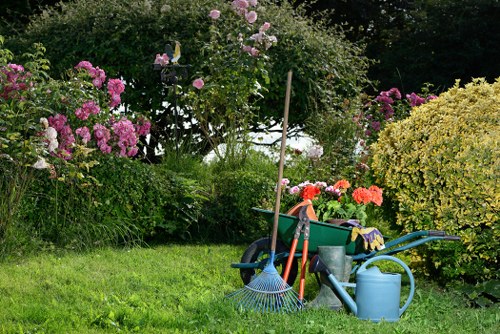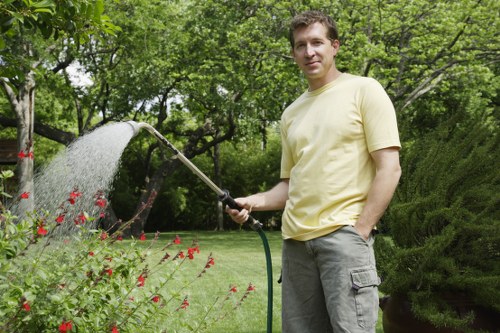Landscape Gardening in Grass Cutting

Introduction to Landscape Gardening
Landscape gardening involves the art and science of designing outdoor spaces to create aesthetically pleasing and functional environments. One of the fundamental aspects of landscape gardening is grass cutting, which not only enhances the appearance of a garden but also contributes to the overall health of the lawn.
Grass cutting is more than just a routine task; it plays a vital role in maintaining the vitality of your garden. Regular mowing helps control weeds, promotes healthy grass growth, and maintains an even lawn surface.
In this article, we will delve into the various techniques and best practices of grass cutting within the realm of landscape gardening, ensuring your outdoor spaces remain lush and inviting.

Benefits of Regular Grass Cutting
Promotes Healthy Grass Growth
Regular mowing encourages grass to grow thicker and healthier. By cutting the grass at the right height, you stimulate the plant to produce more lateral growth, resulting in a denser and more resilient lawn.
Weed Control
Consistent grass cutting helps prevent weeds from taking over your garden. Shorter grass blades shade the soil, making it difficult for weed seeds to germinate and establish themselves.
Enhanced Aesthetic Appeal
A well-maintained lawn significantly boosts the overall beauty of your landscape. Evenly cut grass creates a neat and tidy appearance, making your garden more inviting.

Types of Grass Cutting Techniques
Mowing Height
The height at which you cut your grass plays a crucial role in its health. Different grass types require different mowing heights. For instance, cool-season grasses like Kentucky bluegrass thrive when cut to a height of 2.5 to 3 inches, while warm-season grasses like Bermuda grass prefer a shorter cut.
Frequency of Mowing
Determining the right frequency of mowing depends on the growth rate of your grass, which is influenced by factors such as climate, soil quality, and seasonal changes. As a general rule, mow your lawn once a week during the peak growing season.
Tools and Equipment
Using the appropriate tools is essential for effective grass cutting. Investing in a quality lawnmower suited to your garden’s size and grass type can make a significant difference in the outcome.

Best Practices for Grass Cutting
Sharpen Your Mower Blades
Dull mower blades can tear grass instead of cutting it cleanly, leading to ragged edges and increased susceptibility to disease. Regularly sharpening your mower blades ensures a clean cut and promotes healthier grass growth.
Follow the One-Third Rule
Never cut more than one-third of the grass blade’s height in a single mowing session. This practice reduces stress on the grass and maintains its ability to photosynthesize effectively.
Alternate Mowing Patterns
Changing your mowing pattern regularly prevents grass from developing ruts and compacts the soil less. It also promotes upright growth by encouraging the grass to grow in different directions.

Seasonal Grass Cutting Tips
Spring Maintenance
In spring, focus on removing debris and thatch buildup to allow the grass to breathe. Begin regular mowing as the grass starts to grow, and consider fertilizing to promote vigorous growth.
Summer Care
During the hot summer months, mow your grass higher to provide shade to the roots, reducing water evaporation. Ensure consistent watering and avoid cutting the grass too short.
Fall Preparation
As the growing season winds down, continue mowing regularly to prepare the lawn for winter. Aerate the soil and apply a final round of fertilizer to strengthen the grass for the colder months.
Winter Considerations
While grass growth slows in winter, occasional mowing may be necessary to manage any leftover growth and maintain the lawn’s appearance.
Choosing the Right Lawn Mower
Selecting the appropriate lawn mower is essential for effective grass cutting. There are several types of mowers available, each with its advantages:
- Manual Reel Mowers: Eco-friendly and quiet, suitable for small lawns.
- Electric Mowers: Lightweight and low maintenance, ideal for medium-sized gardens.
- Gas-Powered Mowers: Powerful and efficient, best for large lawns with thick grass.
- Robotic Mowers: Automated and convenient, perfect for those seeking a hands-off approach.
Consider the size of your lawn, the type of grass, and your personal preferences when choosing a mower.
Maintenance of Lawn Mowers
Regular maintenance extends the lifespan of your mower and ensures optimal performance. Clean the mower after each use, check and replace air filters as needed, and regularly inspect the blades for sharpness.
Safety Tips
Always follow safety guidelines when operating a lawn mower. Wear appropriate protective gear, ensure the mower is in good working condition, and keep children and pets away from mowing areas.
Sustainable Grass Cutting Practices
Adopting sustainable practices in grass cutting not only benefits your garden but also the environment. Here are some eco-friendly tips:
- Leave Grass Clippings: Returning grass clippings to the lawn can provide natural fertilizer, reducing the need for chemical fertilizers.
- Use Battery-Powered Mowers: These mowers produce fewer emissions compared to gas-powered ones, contributing to a healthier environment.
- Water Efficiently: Water your lawn during the early morning or late evening to minimize evaporation and conserve water.
- Choose Native Grass Species: Native grasses are well-adapted to the local climate and require less water and maintenance.
Implementing these practices ensures a healthy lawn while promoting environmental sustainability.
Composting Grass Clippings
Grass clippings can be composted to create nutrient-rich soil amendments. Composting reduces waste and provides valuable organic material for your garden plants.
Integrated Pest Management
Maintain a healthy lawn by managing pests naturally. Encourage beneficial insects, use organic treatments, and keep the grass at optimal height to deter pests.
Common Grass Cutting Mistakes to Avoid
Avoiding common mistakes can significantly improve the health and appearance of your lawn. Here are some pitfalls to watch out for:
- Cutting Too Short: Mowing the grass too short can stress the plants, making them vulnerable to weeds and diseases.
- Irregular Mowing: Inconsistent mowing can lead to an uneven lawn and hinder proper grass growth.
- Neglecting Lawn Health: Failing to address underlying lawn issues like poor soil, pests, or diseases can result in a deteriorating lawn.
- Using Dirty Mower Blades: Dull or dirty blades can tear the grass, leading to ragged edges and increased susceptibility to damage.
Proper Cutting Techniques
Employing the right cutting techniques ensures a healthy and beautiful lawn. Always mow in a straight line, avoid sharp turns, and never remove more than one-third of the grass height in a single mowing session.
Seasonal Adjustments
Adapt your mowing practices to the changing seasons. Adjust the mower height and mowing frequency based on the grass growth patterns throughout the year.
Enhancing Your Landscape Through Grass Cutting
Effective grass cutting is a cornerstone of landscape gardening, contributing to the overall beauty and functionality of your outdoor space. By adhering to best practices and incorporating sustainable techniques, you can maintain a vibrant and healthy lawn that enhances your landscape year-round.
Final Thoughts
Investing time and effort into proper grass cutting can yield significant rewards in the form of a stunning and thriving garden. Whether you are a seasoned gardener or a novice, understanding the nuances of grass cutting is essential for achieving the desired landscape aesthetic.
Contact us today to learn more about our professional grass cutting services and transform your garden into a picturesque haven.

